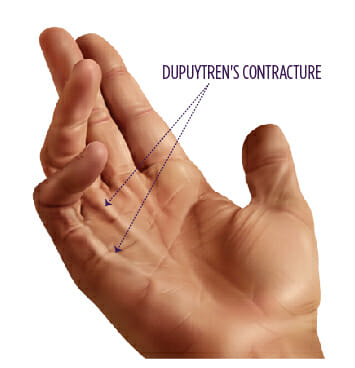
Your hand contains multiple layers of tissue. In a healthy hand, these tissues glide over each other seamlessly. If you have Dupuytren’s contracture (also known as Dupuytren’s disease or Dupuytren’s syndrome), the connective tissue and, in some cases, the skin begins to thicken, which causes the fingers to involuntarily bend toward the palm. This condition commonly occurs in both hands and may slowly worsen with time.
A contracture is a tightening of muscles, tendons, ligaments or skin. The condition gets its name from Guillaume Dupuytren, a French doctor who treated it.
Crooked fingers due to Dupuytren’s contracture can make completing everyday tasks challenging. Because Dupuytren’s disease causes your fingers to bend toward your palm, more severe cases can cause you to have difficulty with normally simple tasks, such as shaking someone’s hand or putting your hand in your pocket.
Hand contracture, such as Dupuytren’s, can worsen over time if not treated.
Summit Orthopedics’ hand and wrist specialists provide expert diagnosis and treatment for Dupuytren’s contracture at locations throughout the Minneapolis/St. Paul area.
Common Symptoms of Dupuytren’s Contracture
Symptoms depend on the severity of your condition. Nodules on the palm of the hand are often the first sign of the condition. Dupuytren contracture symptoms may also include:
- A cord that runs from the palm to the finger (advanced cases)
- Bent or crooked fingers, usually the ring and little fingers
- Bumps, pits or lumps in the palm of the hand that can be painful, are usually firm and move with the skin
- Difficulty using your hand
- Impacts one or both hands
- Inability to lie your hand, palm side down, flat on a table
- Thick tissue bands under the skin in your palms
Dupuytren’s Contracture Causes
While the exact cause of Dupuytren’s disease is unknown, we do know that:
- A history of diabetes increases the risk of developing the condition.
- People with European backgrounds are more likely to develop Dupuytren’s contracture.
- The disease occurs up to six times more often in men than women.
- Tobacco and alcohol use increase the risk.
Diagnosing Dupuytren’s Contracture
During your appointment, your doctor will talk with you about your medical history and your symptoms. They will perform a physical exam, where they will use a tool to measure the contracture and curling of your fingers. They will evaluate the nodules and cords on your palm, as well as your range of motion. They will perform tests to determine your grip strength and your pinch strength. All that information will be recorded so they can compare that information to future measurements.
Your doctor may also perform a simple test called the Hueston tabletop test. During this test, you’ll place your hand—palm side down—flat on a tabletop. If you’re unable to completely flatten your fingers, the Hueston tabletop test is positive and you may have Dupuytren’s contracture.
Nonsurgical Treatment for Dupuytren’s Contracture
Several treatments can slow the disease’s progression and relieve your symptoms. After a physical examination, your doctor will explain the treatment options that are appropriate for your unique situation and create a plan tailored to your needs.
Your custom treatment plan may include:
- Hand therapy: This type of physical therapy involves learning new techniques to move your hand to improve functioning. Dupuytren’s contracture therapy exercises will be taught to you by a physical therapist, and you will continue those exercises at home.
- Injections: Collagenase injections dissolve collagen in the skin and can flatten the thickened skin that’s causing the fingers to bend. These injections are a popular nonsurgical treatment for Dupuytren’s contracture.
- Steroid shots: Injections of steroids can relieve pain in nodules and could prevent symptoms from worsening. You may need shots more than once.
Surgical Treatment of Dupuytren’s Contracture
Minor cases of Dupuytren’s contracture usually don’t benefit from surgery—unless they are especially painful—since surgery may cause the disease to worsen. Advanced stages of Dupuytren’s disease usually require surgery, especially if you cannot straighten your fingers and have difficulty doing daily tasks.
In more advanced cases, though, surgery can successfully:
- Relieve tension of contractures
- Remove abnormal tissue from the palm and fingers
- Restore a normal aesthetic appearance
During the surgery, you will receive a local anesthetic to your hand. Then, your surgeon will make a small incision near the affected finger on the palm side of your hand to remove the flattened tissue and flatten the nodules causing the contracture. The incision is closed with sutures. After surgery, your surgeon may require that you wear a splint.
Dupuytren’s surgery is a minimally invasive outpatient procedure, which means you can go home the same day.
What to Expect After Dupuytren’s Treatment
Although treatment can help relieve some symptoms, Dupuytren’s contracture is a progressive disease that often comes back even after surgery. The good news is that many times the disease progresses slowly, is only mildly painful and has little to no impact on your ability to use your hands for everyday tasks. If this is your situation, you may not need treatment unless your symptoms progress. There currently is no cure for Dupuytren’s contracture.
Find your Summit Orthopedics hand and wrist expert, request an appointment online or call us at (651) 968-5201 to schedule a consultation.
